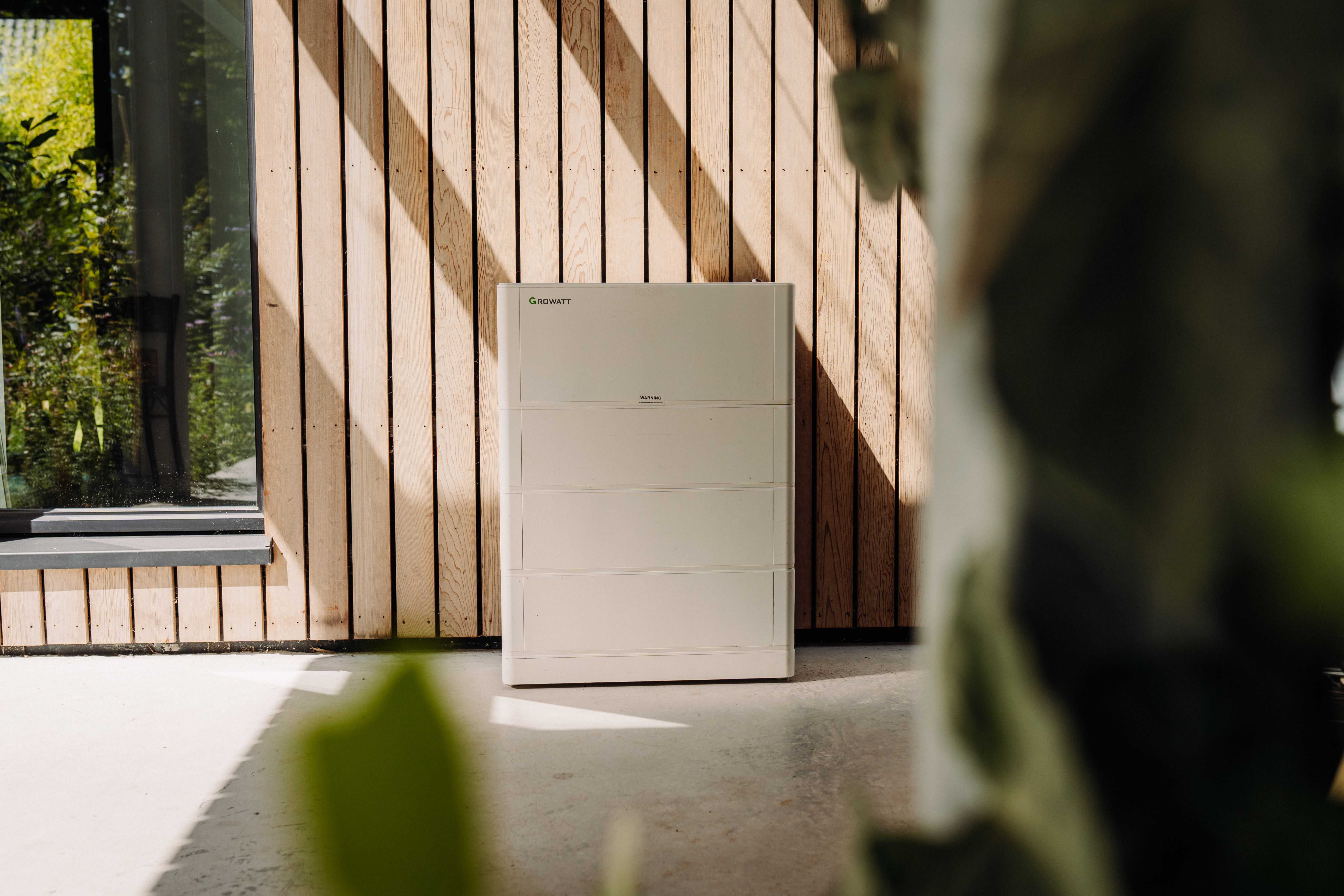A home battery stores your self-generated solar energy — but is it worth the investment? With the reduction of the net metering scheme and fluctuating energy prices, this question is becoming increasingly relevant. A home battery increases your self-consumption and reduces your energy costs, but how profitable is it really? At Chargee, we provide insights into your energy consumption and help you get the most out of your solar panels and energy contract. Let’s dive into the facts and figures!
What is a home battery and how does it work?
A home battery stores solar energy for later use, making you less dependent on the grid. Instead of feeding surplus electricity back into the grid, you use it when your consumption increases or when electricity prices are high. This lowers your energy costs and protects you against fluctuating rates. The battery also helps to flatten peak usage, for example when charging an electric car. Is the battery empty? Then your home automatically switches to grid power. This way, you get the most out of your solar energy.
Does a home battery make you independent from the grid?
A home battery is not a replacement for the power grid. Most home batteries in the Netherlands are connected in parallel and feed energy back into the grid, where your smart meter balances consumption and delivery. This reduces your dependency on the grid, but going completely off-grid with these systems is not yet possible. That would require the battery to power all your appliances — technically complex and more expensive.
The lifespan of a home battery
The lifespan of a home battery depends on the number of charge cycles and how smartly you use it. On average, a home battery lasts 10 to 15 years, but with proper use, this can extend to 20 to 25 years.
A charge cycle — one full charge and discharge — determines how quickly capacity decreases. While 6,000 cycles is a common estimate, some batteries reach 10,000 cycles, extending their life. Fully discharging or constantly keeping the battery at 100% speeds up wear, while partial charging and discharging (e.g. between 20% and 80%) helps preserve the battery.
Many home batteries feature a Battery Management System (BMS) — built-in technology that optimizes charging, prevents overheating, and monitors performance. Ambient temperature also matters: heat can degrade a battery faster. That’s why it’s wise to install your battery in a cool location.
How much capacity does a home battery need?
The right capacity depends on your energy usage and how you plan to use stored energy. The larger the battery, the more solar power you can use yourself and the less you feed back into the grid. Here are some general guidelines:
| Capacity | Suitable for | Advantage | Disadvantage |
|---|---|---|---|
| 5 kWh | 1–2 person households or as a backup power supply | Covers small energy peaks and increases self-consumption | Limited storage, fills up quickly on sunny days |
| 10 kWh | Average families (3–4 people) with solar panels | Good balance between storage and usage | Can still overflow on some days with high solar output |
| 15+ kWh | Large households or high energy users (e.g. EV charging) | Maximum use of solar energy (more grid independence) | More expensive and possibly oversized for lower consumption |
But what’s right for me?
Check your average daily generation and consumption in the Chargee app. Does it match one of the scenarios above? Then you’ll quickly find your best fit. If your usage is seasonal (e.g. AC or heat pumps), use the yearly average and add 20–30%.
Why seasonal storage isn’t possible
A home battery is designed for daily storage. While it can hold a charge for a few days (e.g. during holidays), it runs out without new energy input. That makes it unsuitable for storing summer solar energy into winter.
Batteries also lose energy over time — stored power slowly leaks away. That makes long-term storage impractical. Seasonal storage would require much larger batteries and different technologies (like hydrogen), which are not yet viable for home use.
What kind of inverter do you need?
The inverter is key to your home battery’s performance. It determines how fast the battery charges/discharges and how efficiently solar power is used. A small inverter slows charging, while an oversized one may cause energy losses.
Example: a 10 kWh battery with a 5 kW inverter needs at least 2 hours to fully charge or discharge. A smaller inverter slows this process, while a too-large inverter may be inefficient.
Inverter vs. storage capacity
The inverter is just as important as battery size, because it controls how fast and effectively you can use the stored energy. A weak inverter can’t discharge fast enough to support high-demand appliances.
For example, “plug-in batteries” with 800W capacity are not enough to power an induction cooktop (2,000–6,000W). For optimal performance and higher self-consumption, a fixed setup with a powerful inverter is usually the better choice.
Impact on the electricity grid?
Home batteries help reduce grid congestion by storing energy locally and spreading peak loads. Grid congestion occurs when the grid is overloaded — for example, when many people feed in solar energy at once or charge EVs simultaneously.
Without smart control, however, batteries can also create new peaks if many users charge or discharge at the same time. Dynamic pricing and grid load signals enable smarter battery use, keeping the grid stable and helping you get the most from your storage.
The advantages
- Lower energy costs: you use more of your own solar energy and rely less on the grid. Savings depend on your contract and efficiency.
- Higher self-consumption: surplus solar energy is used later, e.g. in the evening or on cloudy days.
- Protection from grid congestion: when the grid is overloaded, you store energy and stay less affected by feed-in restrictions.
The disadvantages
- Limited storage capacity: a home battery only stores a limited amount, so in winter you’ll still rely partly on the grid.
- No direct return on investment: unlike solar panels, a battery doesn’t earn feed-in compensation. From 2025–2026, grid operators may offer payments for flexible use.
- Dependent on grid load signals: without smart systems, a battery may charge or discharge at suboptimal times, worsening congestion.
What does a home battery cost and how long is the payback time?
The price depends on capacity, brand, tech, and installation. A 10 kWh battery with installation costs around €5,300. Cheaper batteries often store less or charge slower. The C-rate indicates discharge speed:
- 1C = fully discharged in 1 hour
- 0.5C = fully discharged in 2 hours
Some batteries come without an inverter and require a hybrid inverter. A hybrid inverter manages power from both your panels and battery. It decides whether energy goes to your house, battery, or back to the grid — making the system more efficient.
Many existing solar installations




